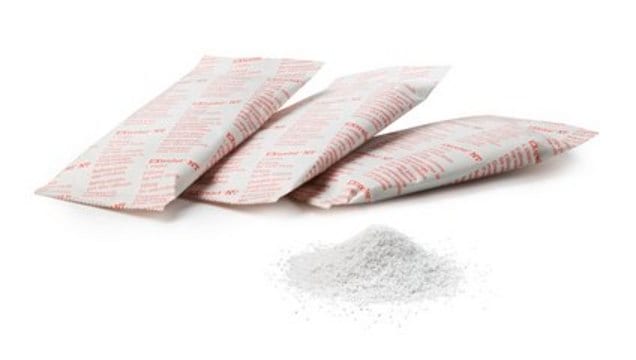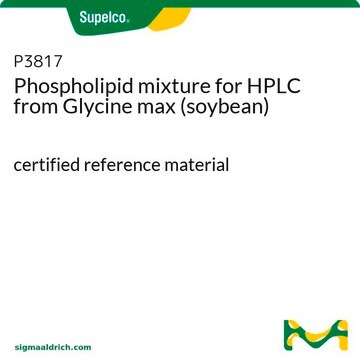55261-U
HybridSPE®-Phospholipid solid phase extraction (SPE) Cartridge
Cartridge, bed wt. 30 mg, volume 1 mL, pk of 100
Synonym(e):
HybridSPE (phospholipid and protein removal) SPE cartridge tube, 1 mL
About This Item
Empfohlene Produkte
product name
HybridSPE®-Phospholipid, Cartridge, bed wt. 30 mg, volume 1 mL, pk of 100
Materialien
PE frit (20 μm)
polypropylene hardware
Produktlinie
HybridSPE®
Zusammensetzung
bed wt., 30 mg
Verpackung
pk of 100
Methode(n)
solid phase extraction (SPE): suitable
Volumen
1 mL
Aktive Matrixgruppe
zirconia-based phase
Suchen Sie nach ähnlichen Produkten? Aufrufen Leitfaden zum Produktvergleich
Allgemeine Beschreibung
Die „In-Well“- und „In-Cartridge“-Fällungsmethoden sind für die 96-Well-Version von HybridSPE-Phospholipid und die Kartusche von HybridSPE-Phospholipid Ultra verfügbar. Dabei wird zunächst biologisches Plasma oder Serum auf die Mikrotiterplatte bzw. in die Kartusche gegeben und dann gesäuertes Acetonitril, das Fällungsmittel. Nach kurzem Mischen/Vortexen wird Vakuum angelegt. Da die Versionen 96-Well und Ultra-Kartusche zahlreiche hydrophobe Filter/Fritten mit geringer Porosität enthalten, funktioniert der gepackte Filter bzw. die gepackte Fritte als Tiefenfilter und ermöglicht so während der Extraktion die Entfernung von sowohl Phospholipiden als auch gefällten Proteinen. Die standardmäßigen HybridSPE-Phospholipid-Kartuschen erfordern eine „Off-line“-Fällung.
Anwendung
- Less is more: a methodological assessment of extraction techniques for per- and polyfluoroalkyl substances (PFAS) analysis in mammalian tissues.: This study assesses various extraction methods, including HybridSPE®-Phospholipid, for analyzing PFAS in tissues, highlighting efficiency and reproducibility (Mertens et al., 2023).
- Rapid analysis of 65 pharmaceuticals and 7 personal care products in plasma and whole-body tissue samples of fish using acidic extraction, zirconia-coated silica cleanup, and liquid chromatography-tandem mass spectrometry.: This paper describes a rapid analytical method incorporating HybridSPE®-Phospholipid for sample preparation, demonstrating its application in environmental toxicology (Tanoue et al., 2020).
Leistungsmerkmale und Vorteile
- Vereint die Einfachheit der Proteinfällung mit der Selektivität der Festphasenextraktion (SPE) durch die gezielte Entfernung von Phospholipiden
- Reduziert die Ionenunterdrückung durch vollständige Entfernung der Phospholipide und gefällten Proteine
- Zwei- bis dreistufige generische Methode
- Geringe bis keine Methodenentwicklung
- Als 96-Well-Platten und 1 mL große Kartuschen erhältlich
- Zur Verwendung in Verbindung mit Offline-Proteinfällungen.
Rechtliche Hinweise
Anwendung
Ähnliches Produkt
Lagerklassenschlüssel
11 - Combustible Solids
WGK
WGK 3
Flammpunkt (°F)
Not applicable
Flammpunkt (°C)
Not applicable
Choose from one of the most recent versions:
Besitzen Sie dieses Produkt bereits?
In der Dokumentenbibliothek finden Sie die Dokumentation zu den Produkten, die Sie kürzlich erworben haben.
Kunden haben sich ebenfalls angesehen
Artikel
This Sigma-Aldrich article continues to detail new methodology for the analysis of Vitamin D metabolites using HybridSPE-Phospholipid technology.
An article focusing on ion-suppression and phospholipid contamination and some of their major causes and difficulties.
This Sigma-Aldrich article discusses how the HybridSPE-Phospholipid Technology works and how the phospholipids are removed.
Protokolle
A simple method to enrich phospholipids from plasma samples, involving a HybridSPE-PPT 96-well plate that both retains phospholipids and removes precipitated proteins.
Verwandter Inhalt
Small molecules are ions and compounds of molecular weight typically less than 900 daltons. These compounds can be effectively separated and analyzed by HPLC, UHPLC and LC-MS using mainly silica particles or monolithic stationary phases with a broad range of column chemistries (modifications).
Niedermolekulare Verbindungen, sogannte Small Molecules, sind neutrale und ionische Verbindungen mit einem Molekulargewicht, das üblicherweise unterhalb von 900 Dalton liegt. Diese Verbindungen können durch HPLC, UHPLC und LC-MS vornehmlich unter Verwendung von Kieselgelpartikeln oder monolithischen stationären Phasen mit einem breiten Spektrum von „Säulenchemien“ (Modifikationen) effektiv getrennt und analysiert werden.
Chromatograms
application for HPLCUnser Team von Wissenschaftlern verfügt über Erfahrung in allen Forschungsbereichen einschließlich Life Science, Materialwissenschaften, chemischer Synthese, Chromatographie, Analytik und vielen mehr..
Setzen Sie sich mit dem technischen Dienst in Verbindung.











